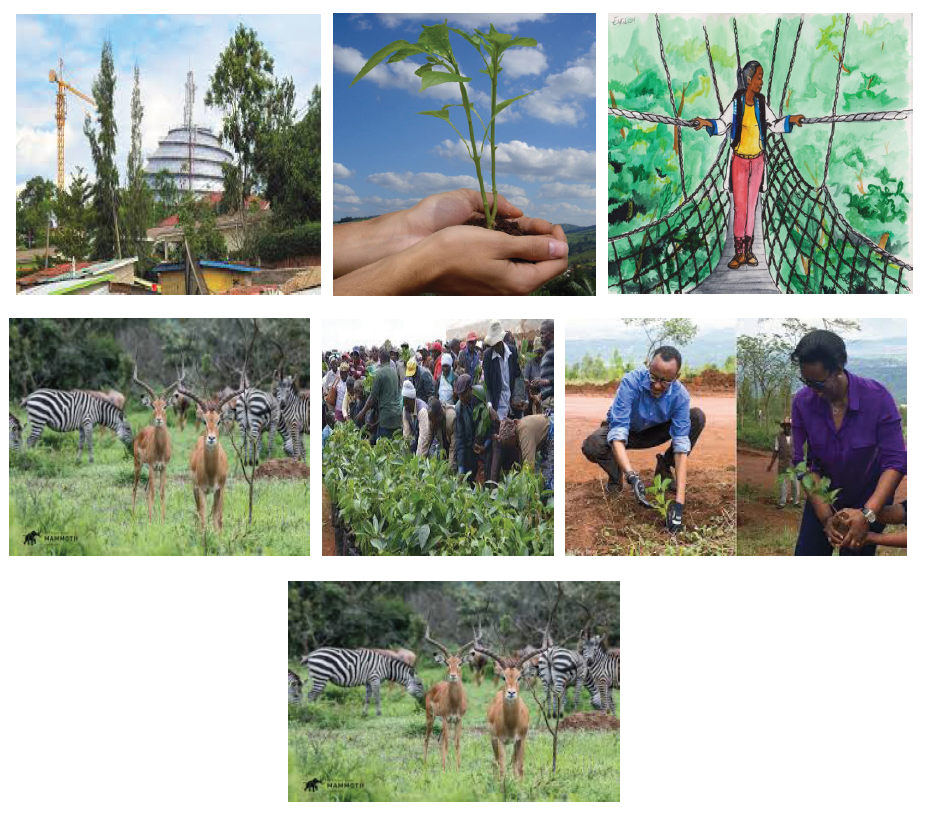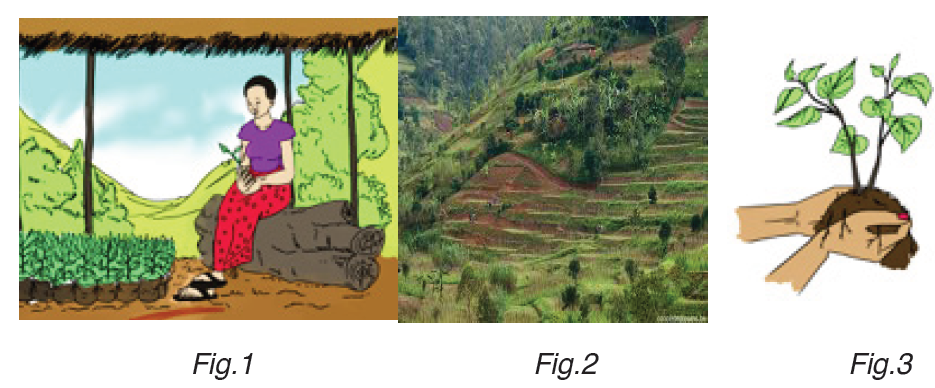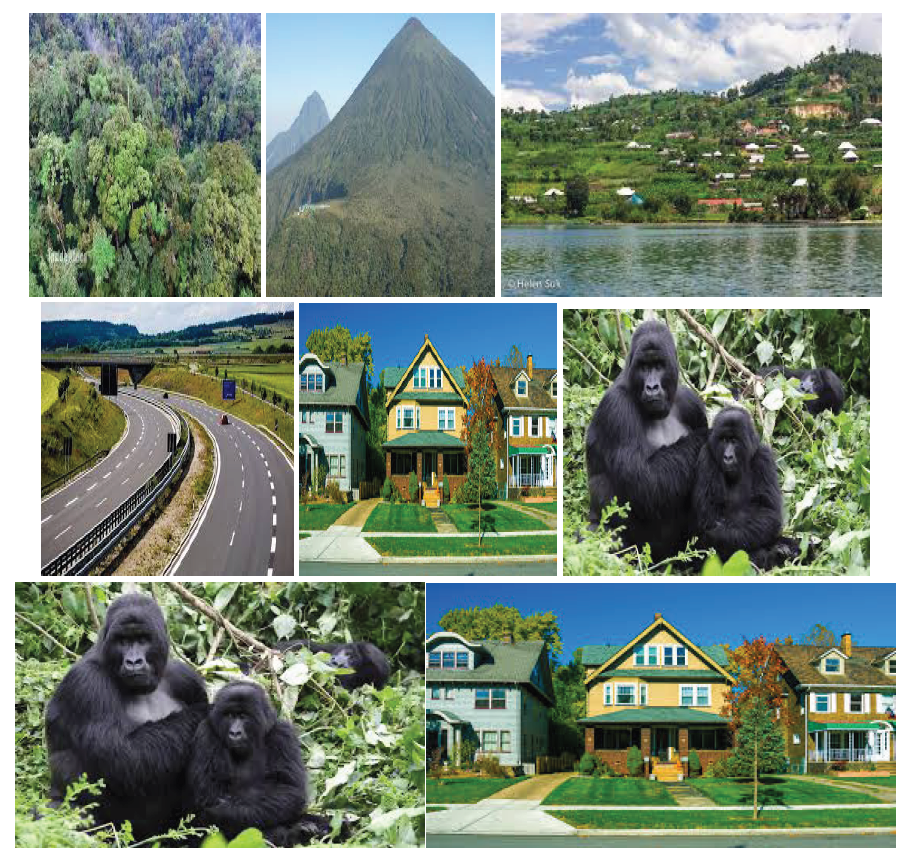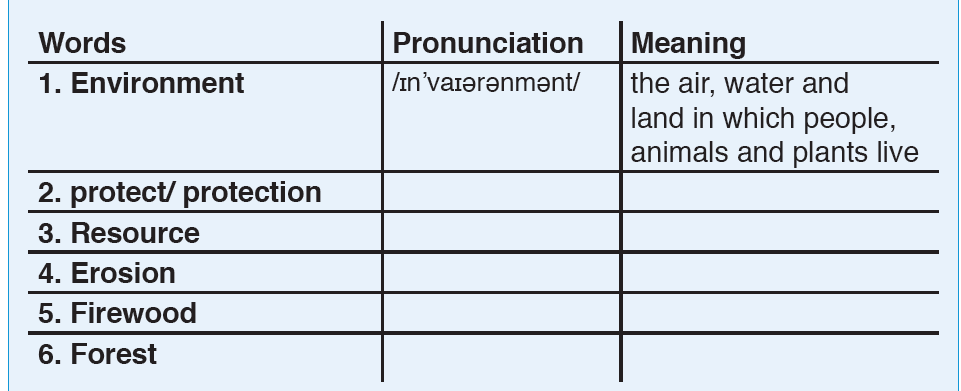UNIT 7: ENVIRONMENT CONSERVATION AND SUSTAINABILITY
Key Unit competence: To use language learnt in the context of Environment Conservation and
Sustainability
Introductory Activity
After observing the above pictures, answer the following questions:
1. What is environment conservation?
2. Who is responsible to conserve and sustain our environment?
3. Why do we need to protect and sustain our environment?
4. Which techniques can we use to protect and sustain our environment?
7.1. Describing different ways of protecting environment
7.1.1. Learning activity Reading and text analysis
7.1.1.1. Picture observation and interpretation
Observe the pictures and interpret what is happening from Figure1-3
Identify different activities that are taking place in the above figures and explain their advantages.
• Text: Safe environment is a source of healthy living.
We only have one planet and we should all do our part to ensure that it’s protected by combining our modern ways of living with a deeper respect and understanding of what nature provides. Environmental conservationists understand that the way we live is a reflection of how we feel about the natural world, and our everyday habits show how much we truly value all the things that the Earth gives us. There is much to do when it comes to rebuilding and protecting what’s left of natural resources and the biodiversity within our ecosystems. Environmental conservation is an umbrella term that defines anything we do to protect our planet and conserve its natural resources so that every living thing can have an improved quality of life. Conservation works in two ways. It is meant to protect nature by protecting vital resources, and it is also a way of living that works against the irresponsible practices.
Environmental conservation comes in many forms and reminds us to be mindful of daily choices. No matter how busy your life may be, it remains fairly easy to make small, yet necessary, changes for the good of the Earth.
If we all took little steps, we would make our way towards major progress.
This can be achieved by paying more attention to what we buy and not using resources unnecessarily. We must also remember to recycle and dispose of chemicals properly so that the ground and bodies of water are not poisoned.
By embracing and promoting alternative energy sources, Mother Earth would be relieved. If every household incorporated the concepts of sustainable living by using less and conserving more, the positive impact would be immeasurable. Then, Environmental awareness and care for our immediate surroundings is cultivated in families and by cultural values before it is learned in formal educational settings such as schools and universities, or in other social settings oriented to bringing attention to environmental issues, such as groups that advocate for protecting nature. Thus, environmental education “includes the provision of information in a systematic and structured way, but usually goes further, encouraging deeper understanding and, perhaps, values and norms regarding behaviours” (Dietz & Stern, 2002) (Box 4).
Deforestation continues to be a major environmental issue. Trees are cut down to provide fuel for cooking, charcoal and more land. Trees are the ‘lungs’ of the earth, absorbing carbon dioxide and releasing oxygen. Their roots also lock moisture in the soil. Without trees, we will experience erosion and a build-up of carbon dioxide. Again, Animals and people lose their food supply and homes, and the economic status of a region can also change because less forests often leads to less employment opportunities in the area.
Planting trees is a way to give back because it aids in the restoration of homes for wildlife, food sources, and medicinal properties that only the trees provide. As trees grow, they protect soil from harsh weather conditions and protect us from excess carbon dioxide, enabling us to live longer and more comfortably. So, when trees are cut down, they must be replaced. But trees
take a long time to grow. We must control the removal of trees to prevent deforestation. Farmers are encouraged to practice agro forestry where they plant trees on their farms together with the crops and making terraces especially on high mountains. The government and many large corporations play a big part in how we make use of the Earth’s resources, but they aren’t the only ones who determine the impact we have on the planet. With so many of us on this Earth, we can make all the difference in the world hence healthy living.
• Comprehension questions.
a. What is environment protection?
b. What does the author mean by trees being the ‘lungs’ of the earth?
c. Why do people cut down trees?
d. How can deforestation be prevented?
e. Give reasons why the author said that safe environment is source of living.
f. Explain some of the ways of protecting environment.
• Vocabulary activity
Explain the following words using your dictionaries
1. Terraces
2. Conservation
3. Agro-forestry
4. Deforestation
5. Carbon dioxide
7.1.2. Application activity Essay writing
Write an essay of about one page on the topic of pollution and exploitation of Environment. You can include in your essay statements such as:
• We cut down too many trees, and therefore...
• We put too much waste into rivers, and therefore...
• We make too many fires, and therefore...
• We build too few terraces, and therefore...
7.2. Describing environmental features and their roles
7.2.1. Learning activity Reading and text analysis
Picture observation and interpretation
Observe the picture and answer questions that follow:
Explain what the above picture represents.
• Text: Know your country.
Read the following text and answer the questions below:
Our country is known as the “land of a thousand hills,” it is a mountainous country located on the far western edge of the Rift Valley, bordering on Burundi, the Democratic Republic of Congo, Uganda, and Tanzania. Rwanda rises from relatively flat plains in the east along the Tanzania border to steep mountains in the west along the continental divide between the Congo and Nile rivers. From the continental divide, the land drops sharply to the shores of Lake Kivu, which forms most of Rwanda’s border with Congo. A range of high volcanoes forms Rwanda’s northwest border. The mountainous topography continues in the North Kivu region of Congo, where almost half of the population identifies as Rwandan.
Rwanda is a landlocked country, a member of East Africa situated in central Africa. It has five volcanoes, 23 lakes and numerous rivers, some forming the source of the River Nile. The country lies 75 miles south of the equator in the Tropic of Capricorn, 880 miles ’as the crow flies’ west of the Indian Ocean and 1,250 miles east of the Atlantic Ocean - literally in the heart of Africa.
Rwanda is bordered by Uganda to the north, Tanzania to the east, Burundi to the south and the Democratic Republic of Congo to the west. So, anyone visiting ’The Land of a Thousand Hills’ is in for a multitude of surprises. The loveliness and variety of the landscapes in this ’green country’ is dominated to the north by volcanoes and bordered by Lake Kivu to the west.
We cannot forget the great animals of the wild are protected from poachers and roam free in the vast national parks. The Volcanoes National Park in the Virunga volcanic mountains with its high altitude forests is world famous for mountain gorillas - timid and passive family oriented giants. The Park is teeming with wildlife both large and small, while Lake Kivu to the west offers beautiful beaches, jutting peninsulas and an archipelago of islands.
In addition, the watershed between the major Congo and Nile drainage basins runs from north to south through Rwanda, with around 80 percent of the country›s area draining into the Nile and 20 percent into the Congo via the Rusizi River. The country›s longest river is the Nyabarongo, which rises in the south-west, flows north, east, and southeast before merging with the Akanyaru to form the Akagera; the Akagera then flows due north along the eastern border with Tanzania. The Nyabarongo-Akagera eventually drains into Lake Victoria, and its source in Nyungwe Forest is a contender for the as-yet undetermined overall source of the Nile.
Rwanda has many lakes, the largest being Lake Kivu. This lake occupies the floor of the Albertine Rift along most of the length of Rwanda›s western border, and with a maximum depth of 480 metres (1,575 ft), it is one of the twenty deepest lakes in the world. Other sizeable lakes include Burera, Ruhondo, Muhazi, Rweru, and Ihema, the last being the largest of a string of lakes in the eastern plains of Akagera National Park.
And for Mountains, they dominate central and western Rwanda also part of the Albertine Rift Mountains that flank the Albertine branch of the East African Rift. This branch runs from north to south along Rwanda’s western border. The highest peaks are found in the Virunga volcano chain in the northwest; this includes Mount Karisimbi, Rwanda’s highest point, at 4,507 metres (14,787 ft).
Finally, as long as our physical environment is concerned, it supports all life forms. Rocks, soils, minerals, air, water, microbes, fungi, plants and animals work together to support life and its ability to provide all the other benefits– provisioning, regulating and cultural. The capacity of the environment to support all of this depends on trillions of physical, chemical and biological
interactions. Our understanding of these is just beginning to unravel how sensitive some systems are, and how resilient others can be.
• Comprehension questions
1. What is the role of the following features:
a. Forests b. Lakes
2. Why do we call our country the land of a thousand hills?
3. Identify the lakes discussed by the author.
4. Give reasons why our physical features need to be protected.
5. Suggest some pieces of advice to people who destroy always our physical features.
7.2.2. Application activity Composition writing
Write a composition describing physical features found in the region of Virunga park.
7.3. Talking about physical environment
7.3.1. Learning activity Reading and text analysis
• Text: Our physical environment
Read the following text and answer the questions that follow:
Some people are healthier than others because the environments in which they live, learn, work and play provide more opportunities and supports for healthy behaviour. A healthy environment begins with clean, safe water, air and land we are fortunate that there is little pollution and few contaminants in the country. Our ability to interact with nature on a daily basis gives us a clear advantage over most other people. The natural environment and our connections to the land, water, animals and plants are a fundamental component of building and sustaining good health.
In the past, people travelled by foot, and survived by hunting, gathering and growing their own food. Our ancestors were close to the land and experienced the many benefits of nature. Physical activity was not exercise, it was part of daily life.
Today, we must pay attention to how buildings, roads and walkways, and public spaces are designed so that neighbourhoods are safe and people can be active. Communities that are spread out like Whitehorse can make us more reliant on cars to get around. It’s easy to see how being physically active becomes “working out” rather than part of regular daily activities.
Stores that stock healthy foods and restaurants that serve healthy foods at affordable prices are also examples of physical environments which make healthy choices possible and easier. When it comes to activity and eating, even small changes in the immediate environment can make a difference in what we do. Safe, visible stairwells make it easier to take the stairs rather
than the elevator, and labelling healthier choices at restaurants can prompt us to order a salad instead of other meals.
Adapted from S2 English text book, unit 6 and from www.yukonwellness.ca
• Comprehension questions
Why some people get healthier than others?
Explain the importance of environment as discussed by the author.
Compare and contrast the exploitation of environment in the past and today.
Which advice would you give to people who do not do physical sports?
7.3.2. Application activity Debate and Composition writing
1. Conduct a debate on the following topic. Find the guidelines in unit 5 of this book. ‘Technology has brought more harm to the
environment than good.”
2. Write a composition about the following topic. Find the guidelines in unit 5 of this book. “Without safe environment, people’s
activities are meaningless.”
7.4. Language structure: expressions of purpose
1. Identify the phrases used for expressing the purpose of actions in the following extracts:
a. There are a number of different actions that environmentalist can take in order to reduce soil erosion.
b. The new device is used for locating the position of cars at anytime. It is easy to install and uses satellite navigation which leads
to approximately 97% coverage and accuracy.
c. There are a number of different actions that laboratory users can take to reduce potential hazards when working with human blood.
Gloves should be worn at all times so that the skin of the hands is protected against exposure. To avoid contamination when there is a danger of splattering, gloves, a laboratory coat or gown, eye protection, and a mask should be worn. So as to reduce the danger if contact does occur, all users should be immunised against the hepatitis B virus.
d. This key is for opening the front door, and that one is for the back.
e. Keep on planting trees in order to attract the rain and enjoy the flesh environment.
• Notes
Use of expressions of purpose:
Affirmative to + infinitive
He started drinking alcohol to run away from reality.
I need a chair to sit down.
Negative so as not to + infinitive
- I’ll take a taxi so as not to be late
- Take your shoes off so as not to wake them up
Different subjects so that + subject + can
- I’ll open the door so that he can enter.
- She covered the hole so that water couldn’t come in.
N.B. We use could when the main clause is in the past. instead of can/
could you may also find: may/might, will/would/should.
More colloquial for + subject + to
(+) I’ll open the door for you to enter.
(-) I’ll close the door for you not to go out.
General purpose (definitions) for + -ing
- A tin opener is something for opening tins.
- That’s for peeling potatoes
• It should be noted that after prepositions and conjunctions the ing form of the verb.
If it is about a particular use of something we can’t use “for”.
Example: I need a tin-opener to open this tin.
Exercise:
Choose the correct phrase for the following:
1. They planted many trees _ They could really enjoy the beauty of our environment.
a. Tob. So as to
c. In order to
2. We worked hard just before Christmas _ we could really enjoy the holiday.
a. To
b. So as to
c. In order to
3. This oven is used _ bread.
a. for make
b. to make
c. for making
7.5. End unit assessmentI. Spelling and pronunciation
Provided the example of pronunciation and meaning of the word environment.
Fill in the gaps left out by appropriate pronunciations and meanings of given
words.
II. Complete the following sentences using an appropriate word or
phrase.
1. I talked to the shy girl ............................ she wouldn’t feel left out.
a. for
b. to
c. so
2 We stopped at the pub .............................. a drink.
a. to have
b. for having
3. We stopped at the pub ........................ a drink.
a. ..for
b. ..for having
c to4. I went to Canada ............................ my brother.
a. to see
b. for seeing
5. Sort your rubbish .............................. recycling.
a. to
b. for
c. so
6. I took the phone back to the store ....................... a replacement.
a. to get
b. for getting
7. We started early ........................... we wouldn’t be late.
a. so
b. so that
8 You need to be over 18 ......................... that film.
a. for watching
b. to watch
9. I am leaving early today ........................... the rush hour traffic.
a. for avoiding
b. to avoid
III. Write short notes on the following questions:
a. Why is it important to protect our resources?
b. Why do people cut down trees?
c. What happens to the soil when too many trees are cut down?
d. What happens to the soil when too much fertilizer is used?
e. How do lakes become polluted?
f. What happens to people when they eat too little protein?
IV. Write a short text describing different ways of protecting
environment using expressions of purpose.
